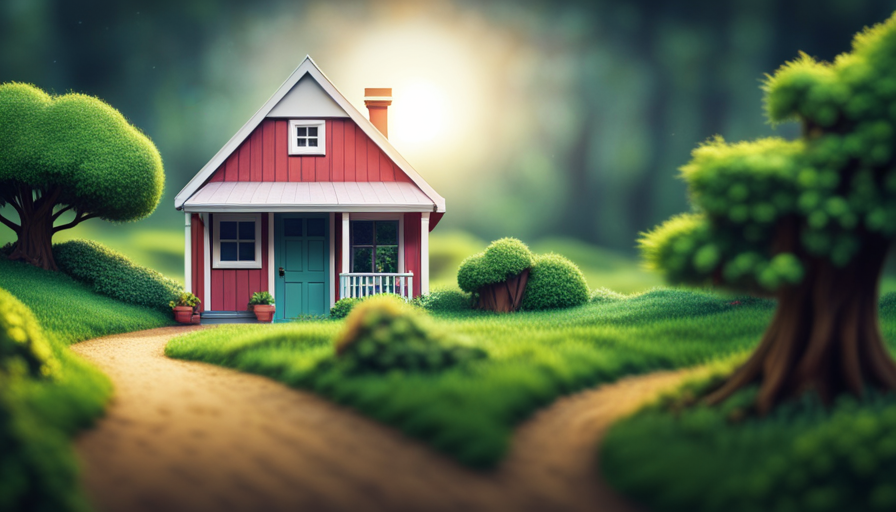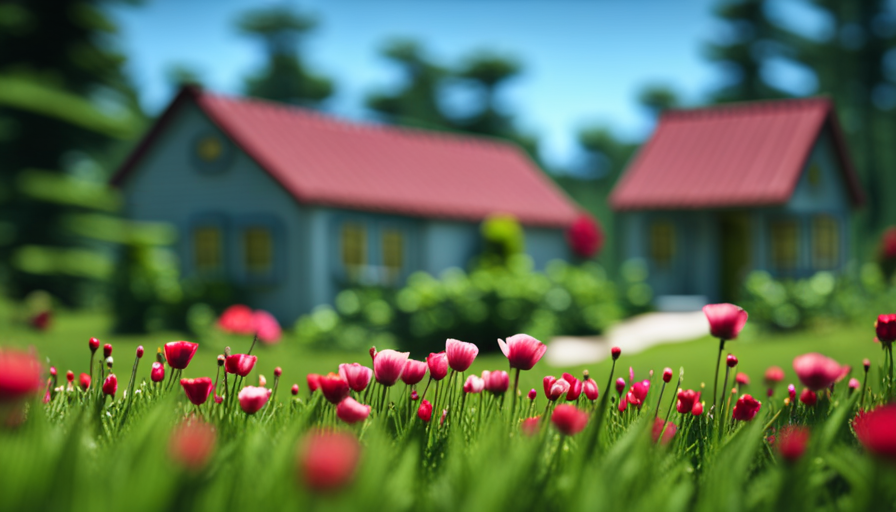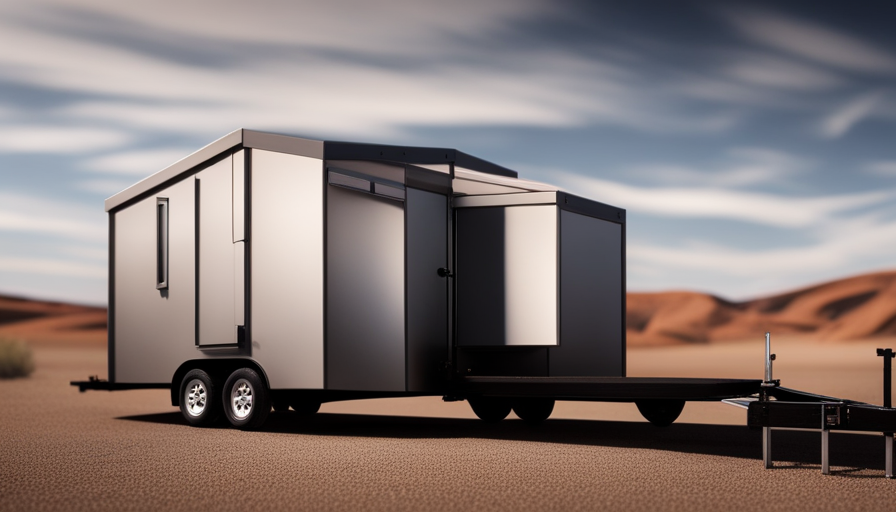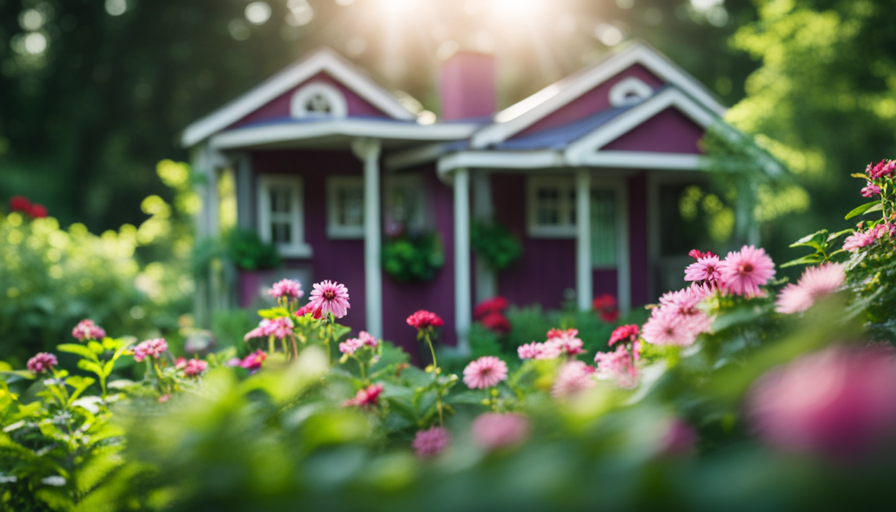Imagine yourself standing at the peak of a mountain, taking in the breathtaking view of the world below. As you gaze into the distance, you spot a cozy cabin nestled in the woods, embodying the ideals of simplicity and freedom.
It’s a dream many of us share – to embrace a minimalist lifestyle and own a tiny house. But how long will it take to pay off this idyllic dwelling? In this article, we will explore the factors that determine the timeline for paying off a tiny house mortgage.
From the size of the mortgage and interest rates to monthly payments and loan terms, we will dive into the financial aspects that impact your journey towards debt-free tiny house living. Additionally, we will discuss strategies for accelerating mortgage payoff and achieving your financial goals.
So, let’s embark on this analytical journey to uncover the secrets of paying off a tiny house and turning your dream into a reality.
Key Takeaways
- Tiny house mortgages have smaller mortgage amounts and lower down payment requirements, making them more affordable than traditional homes.
- The loan approval process for tiny house mortgages is similar to regular home loans, with potentially more lenient requirements.
- The payoff time for a tiny house mortgage depends on the interest rate and size of monthly payments, with higher interest rates resulting in more interest paid over time.
- Strategies such as making additional payments, cutting back on expenses, and increasing income through side gigs or freelancing can accelerate mortgage payoff and achieve financial freedom sooner.
Size of the Mortgage
How long does it take to pay off a tiny house mortgage? Well, it all depends on the size of the mortgage.
When it comes to buying a tiny house, the mortgage amount is typically smaller compared to a traditional home. This is because tiny houses are generally more affordable. The down payment requirements for a tiny house mortgage are also usually lower, making it easier for people to get into homeownership.
The loan approval process for a tiny house mortgage is similar to that of a regular home loan. Lenders will consider factors such as credit score, income, and debt-to-income ratio. However, since the mortgage amount is smaller, some lenders may have more lenient requirements.
Once you secure a tiny house mortgage, the next step is to start paying it off. The length of time it takes to pay off the mortgage will depend on factors such as your interest rate and the size of your monthly payments.
Speaking of interest rates, let’s move on to the next section to explore how they can impact the time it takes to pay off your tiny house mortgage.
Interest Rate
To speed up the process, you’ll want to consider the interest rate on your cozy abode. The interest rate plays a significant role in determining the overall cost of your tiny house and how long it will take to pay it off.
A higher interest rate means you’ll end up paying more in interest over the life of the mortgage. On the other hand, a lower interest rate can save you thousands of dollars. It’s important to shop around and compare rates from different lenders to ensure you’re getting the best deal.
The impact of inflation should also be taken into account when considering the interest rate. Inflation can erode the value of your money over time, making it harder to pay off your mortgage in the long run. Additionally, your credit score requirements will affect the interest rate you qualify for. Lenders typically offer lower rates to borrowers with higher credit scores, as they are seen as less risky.
Considering these factors, it’s crucial to carefully evaluate the interest rate on your tiny house mortgage. A lower rate can save you money and shorten the time it takes to pay off your loan.
In the next section, we’ll discuss how the interest rate affects the monthly payment amount.
Monthly Payment Amount
When you secure a mortgage for your cozy abode, the monthly payment amount becomes a key consideration in your financial planning. It is important to carefully analyze the affordability of your monthly payment to ensure that it fits within your budget.
Here are four factors to consider when evaluating the monthly payment amount for your tiny house:
-
Income: Calculate your monthly income and determine what percentage of it can comfortably go towards your mortgage payment. This will give you an idea of how much you can afford to pay each month.
-
Expenses: Take into account your monthly expenses such as utilities, groceries, and other bills. Subtract these expenses from your income to get a clear picture of how much you can allocate towards your mortgage payment.
-
Comparison with traditional home mortgages: Compare the monthly payment amount for your tiny house mortgage with that of a traditional home mortgage. Consider the potential savings or additional costs associated with each option.
-
Future financial goals: Think about your long-term financial goals and how the monthly payment amount for your tiny house mortgage aligns with them. Consider whether the payment amount allows you to save for other goals such as retirement or travel.
Analyzing the affordability of your monthly payment is crucial when considering a mortgage for your tiny house.
In the next section, we will discuss the length of the loan term and its impact on your financial planning.
Length of the Loan Term
Considering the lengthy commitment you’ll have to make, you’ll be astounded by the impact that the loan term length can have on your financial planning for your adorable little abode. The flexibility of the loan term is an essential factor to consider when determining the length of time it will take to pay off your tiny house.
Opting for a shorter loan term means you’ll be debt-free sooner, but it also means higher monthly payments. On the other hand, a longer loan term provides lower monthly payments but extends the time it takes to pay off the loan.
The loan term length also has a significant impact on the total cost of your tiny house. A shorter loan term means you’ll pay less interest over the life of the loan, resulting in a lower overall cost. Conversely, a longer loan term means more interest payments, increasing the total cost of your tiny house.
Understanding the loan term flexibility and its impact on the total cost of your tiny house is crucial for effective financial planning. By carefully considering the loan term length, you can determine the monthly payment amount that best fits your budget while minimizing the total cost.
Transitioning into the subsequent section about ‘additional payments,’ it’s important to explore how these extra payments can further expedite the loan payoff process and reduce the overall cost of your adorable little abode.
Additional Payments
Pumping extra money into your loan can speed up the payoff process and bring you closer to owning your dream home. By making additional payments, you can reduce the principal amount faster and save on interest over the life of the loan. But how can you find the extra money to put towards your tiny house loan? Here are some savings strategies and budgeting tips to consider:
- Cut back on discretionary expenses: Identify non-essential items or services that you can live without and redirect those funds towards your loan payments.
- Create a monthly budget: Track your income and expenses to see where you can make adjustments. Allocate a portion of your budget specifically for additional loan payments.
- Increase your income: Explore ways to boost your earnings, such as taking on a side gig or freelancing.
Implementing these savings strategies and budgeting tips can help you accumulate extra funds to pay off your tiny house loan faster. Once you have a clear understanding of your income and financial stability, you can take appropriate steps to manage your loan effectively and achieve homeownership sooner.
Income and Financial Stability
To achieve financial stability and maximize my income potential, it’s essential for me to explore alternative avenues for earning money, such as taking on a side gig or freelancing. These additional sources of income can provide a steady stream of cash flow and help me pay off my tiny house faster.
Here are some budgeting techniques and ideas to consider:
-
Creating a detailed budget: Tracking expenses and setting financial goals can help me better understand my income and spending habits. This will allow me to identify areas where I can cut back and save more money.
-
Diversifying income streams: Relying on a single source of income can be risky. By diversifying my income through side gigs or freelancing, I can have multiple streams of income that can contribute towards paying off my tiny house.
-
Investing in education and skills: Enhancing my skills and knowledge through education or training can lead to higher-paying job opportunities or freelancing gigs.
-
Saving and investing: Setting aside a portion of my income for savings and investments can help me build wealth over time and provide financial stability.
By implementing these income stability and budgeting techniques, I can make progress towards paying off my tiny house while also securing my financial future.
Transitioning into the subsequent section about the cost of living expenses, it’s important to consider how these expenses can impact my ability to pay off my tiny house.
Cost of Living Expenses
When it comes to living in a tiny house, one of the key factors to consider is the cost of living expenses. While the primary advantage of a tiny house is its affordability, it’s important to budget for ongoing expenses to ensure financial stability.
To make the most of your tiny house lifestyle, there are several cost-saving tips to keep in mind. First, consider downsizing your possessions to minimize storage costs. Additionally, adopting energy-efficient habits such as using LED lights and investing in insulation can significantly reduce utility bills. Planning meals and shopping in bulk can also help save money on groceries.
By carefully budgeting for living expenses and implementing these cost-saving measures, you can maximize the financial benefits of living in a tiny house.
Transitioning to the next section about the potential for increasing income, it’s important to explore various opportunities to boost your earning potential while living in a tiny house.
Potential for Increasing Income
Maximizing my earning potential while residing in a tiny house offers a plethora of opportunities for increasing income. One way to increase income is by exploring various side hustles for extra cash.
With the rise of the gig economy, there are numerous options available to generate additional income without the need for a traditional 9 to 5 job. One popular side hustle is freelancing. Whether it’s writing, graphic design, or website development, freelancing allows individuals to monetize their skills and work on projects on a flexible schedule.
Another option is renting out a spare room or the entire tiny house through platforms like Airbnb. This can provide a steady stream of income, especially if the tiny house is located in a desirable area.
Additionally, launching an online business or selling handmade products can be a lucrative endeavor. With the convenience of e-commerce platforms, it has never been easier to start a small business from the comfort of my tiny house. I can create and sell products or offer services that align with my interests and skills.
By exploring these ways to increase income and taking advantage of the opportunities available, I can make progress towards my financial goals and priorities. Transitioning into the subsequent section about ‘financial goals and priorities’, it is important to consider how these additional sources of income can contribute to paying off my tiny house faster and achieving financial stability.
Financial Goals and Priorities
Achieving financial stability and setting goals that align with your priorities is essential for long-term success. When it comes to financial planning for your tiny house, it’s important to consider your financial goals and priorities.
Here are four key points to consider:
-
Define your financial goals: Start by clearly defining what you want to achieve financially. Do you want to pay off your tiny house as quickly as possible? Or are you more focused on saving for retirement or starting a business? Identifying your goals will help you develop a plan to achieve them.
-
Create a budget: A budget is a crucial tool for managing your finances effectively. It allows you to track your income, expenses, and savings. By creating a budget, you can identify areas where you can cut back on expenses and redirect that money towards paying off your tiny house.
-
Prioritize saving strategies: Saving strategies such as setting aside a portion of your income each month or finding ways to increase your income can help you reach your financial goals faster. Consider automating your savings or finding side hustles to boost your income.
-
Review and adjust: Regularly review your financial goals and progress to ensure that you’re on track. Adjust your strategies and priorities as needed to stay focused on paying off your tiny house.
By implementing these financial planning and saving strategies, you can work towards achieving your goals and ultimately accelerate the payoff of your mortgage.
Strategies for Accelerating Mortgage Payoff
To quickly accelerate the payoff of your mortgage, consider implementing strategies that can help you reach financial freedom sooner.
One effective approach is to focus on debt reduction strategies. By actively working towards reducing your overall debt, you can allocate more funds towards paying off your tiny house.
Start by analyzing your current financial situation and identifying areas where you can cut back on expenses. This could include reducing discretionary spending, finding ways to save on utilities, or even downsizing your belongings.
Additionally, consider implementing budgeting techniques that can help you allocate more money towards your mortgage payments. This could involve creating a detailed budget and tracking your expenses to ensure you’re staying on track.
Another strategy is to make extra payments whenever possible. By making additional payments towards your mortgage principal, you can reduce the overall amount of interest you pay over time.
Finally, consider exploring opportunities to increase your income. This could involve taking on a side gig or finding ways to earn passive income.
By combining these strategies, you can accelerate the payoff of your tiny house and achieve financial freedom sooner.
Frequently Asked Questions
What are the different types of tiny house mortgages available?
There are several types of tiny house mortgages available, each with their own advantages and disadvantages.
One option is a traditional mortgage, which offers lower interest rates but may require a larger down payment.
Another option is a chattel mortgage, which treats the tiny house as personal property and can be easier to qualify for.
Additionally, some people opt for personal loans or RV loans to finance their tiny house.
It’s important to carefully consider the terms and requirements of each option before choosing the best fit for your situation.
How does the size of the down payment affect the length of time it takes to pay off a tiny house?
The size of the down payment can have a significant impact on the length of the mortgage for a tiny house. A larger down payment means borrowing less money, which can result in a shorter mortgage term. By reducing the principal amount, the monthly payments can be lower, allowing for a faster repayment.
On the other hand, a smaller down payment may lead to a longer mortgage term, as more money needs to be borrowed and paid off over time.
Can I refinance my tiny house mortgage to get a lower interest rate?
Yes, it’s possible to refinance a tiny house mortgage to get a lower interest rate. Refinancing options can provide benefits such as reduced monthly payments and overall interest savings. By refinancing, you can take advantage of current market conditions and potentially secure a more favorable rate. This can help you save money over the life of your mortgage and potentially pay off your tiny house sooner.
Are there any tax benefits or deductions for owning a tiny house?
As a tiny house owner, I’ve found that there are potential tax benefits and deductions available. The specific deductions and benefits will depend on various factors such as whether your tiny house is considered a primary residence or a rental property.
Some potential deductions include mortgage interest, property taxes, and certain home office expenses. It’s important to consult with a tax professional to understand the specific tax benefits and deductions that apply to your individual situation.
What are the pros and cons of renting out my tiny house to generate additional income?
Renting out a tiny house: Is it worth it? Well, let’s dive into the pros and cons of generating additional income through rental.
On the upside, renting out your tiny house can be a great way to make some extra cash and maximize the use of your property. You might even meet interesting people along the way.
However, challenges like maintenance, finding reliable tenants, and potential wear and tear on your beloved tiny abode should also be considered. So, weigh the benefits and challenges before taking the plunge!
Conclusion
In conclusion, there are several factors to consider when determining how long it’ll take to pay off a tiny house mortgage. The size of the mortgage, interest rate, monthly payment amount, and length of the loan term all play a role.
Additionally, making additional payments and considering the cost of living expenses can significantly impact the payoff timeline. One interesting statistic to note is that by increasing income or using strategies to accelerate mortgage payoff, it’s possible to pay off a tiny house mortgage in as little as 5-10 years, allowing for financial freedom and a simplified lifestyle.
Hi, I’m Emma. I’m the Editor in Chief of Tiny House 43, a blog all about tiny houses. While tree houses are often associated with childhood, they can be the perfect adult retreat. They offer a cozy space to relax and unwind, surrounded by nature. And since they’re typically built on stilts or raised platforms, they offer stunning views that traditional homes simply can’t match. If you’re looking for a unique and romantic getaway, a tree house tiny house might just be the perfect option.










